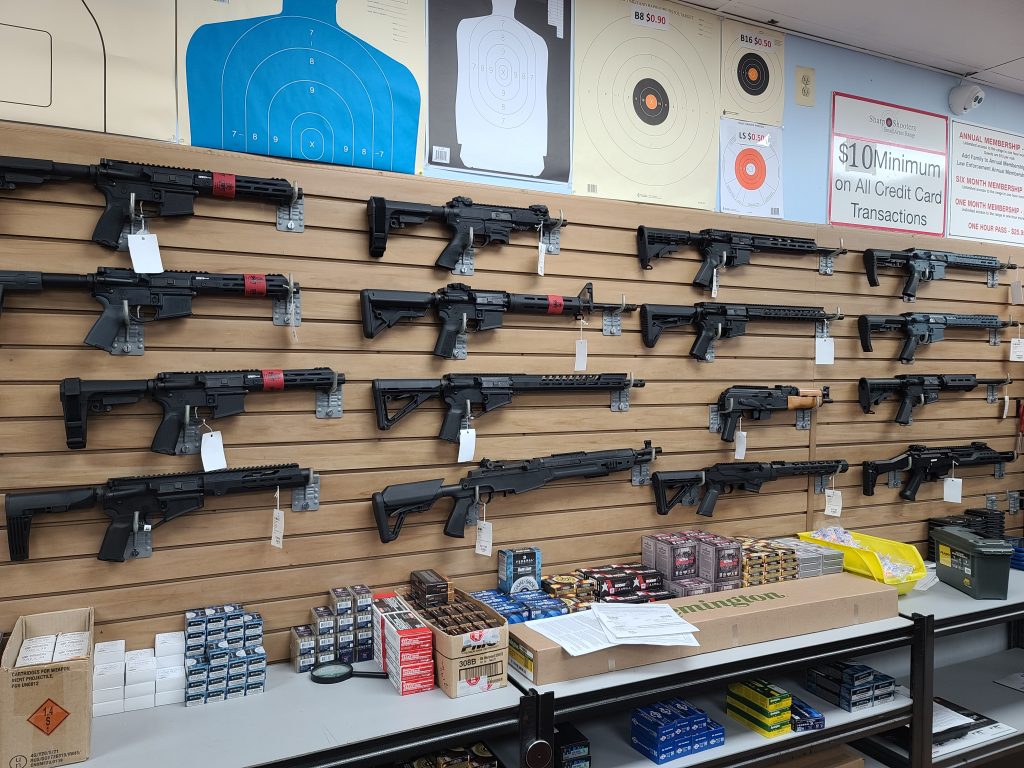Colorado’s legislature is back in session. For the last two years, gun-control advocates have tried to pass a traditional “assault weapon” ban without success. This year, they’ve rebranded the effort.
Contributing Writer Jake Fogleman explains why the new bill seems to have a much better shot at passing. After all, it’s already picked up the support it needs to pass. That includes the backing of a key Democratic lawmaker.
Plus, I look at how developments from the last month give the NRA an opportunity for a fresh start. NRA board member Rocky Marshall joins the podcast to give the reformers’ view of where the group is headed.
However, multiple sources told me on Saturday there is a new internal fight over whether to appeal the final decision in the group’s corruption trial. So, maybe things aren’t as settled as they seem, and the fresh start is just an illusion. I’ll let you all know once I know more.

Analysis: Unpacking Colorado’s New Semi-Auto Ban Bill, Odds of Passage [Member Exclusive]
By Jake Fogleman
Unchastened by two recent failed attempts, Colorado lawmakers are back with another effort to prohibit AR-15s and other semi-automatic firearms. There’s reason to think the third time could be the charm.
The Colorado General Assembly officially gaveled back in Wednesday for the 2025 legislative session. By the end of the day, lawmakers had already introduced Senate Bill 25-003. The “Semiautomatic Firearms & Rapid-Fire Devices” bill would criminalize the manufacture, distribution, transfer, and purchase of any “specified semiautomatic firearm,” defined as any semiautomatic rifle, shotgun, or gas-operated handgun with a detachable magazine.
Essentially, the bill is a reframing of an already novel twist on “assault weapon” ban legislation first floated in the US Senate in 2023. The Gas-Operated Semiautomatic Firearm Exclusion (GOSAFE) Act, introduced by Senators Martin Heinrich (D., N.M.) and Angus King (I., Maine), marked the first legislative effort to ban semi-automatic firearms with detachable magazines while promoting limited-capacity, fixed-magazine alternatives.
The Senators billed it as a more serious alternative to traditional assault weapon bans because it focused on “how these weapons actually work” and the features that “make them especially dangerous” instead of “using the appearance of these guns to restrict them.” However, the language of the proposal targets guns with all kinds of actions rather than just gas-operated guns–despite what the name implies.
Senate Bill 25-003, according to its legislative text and its boosters, takes that concept and reframes it as “enforcement of [Colorado’s] large-capacity magazine ban.”
Though it sheds the GOSAFE Act’s moniker, its influence is unmistakable. The handguns covered under SB 25-003, for instance, are defined verbatim as they were under the GOSAFE Act. It similarly empowers the attorney general’s office with broad discretion to determine which firearm models are banned under the measure. SB 25-003 also goes after rate-of-fire modifications like bump stocks, though it does so in a less sophisticated, more sweeping way than its progenitor.
The banned “rapid-fire devices” under the bill would include any part or combination of parts that have the effect of “increasing the rate of fire of a semiautomatic firearm above the standard rate of fire” for the gun being modified. That could implicate more anodyne modifications, like precision triggers, alongside machinegun conversion kits.
As a result, the bill takes a far broader approach to outlawing common semi-automatic firearms than the traditional features-based bans floated and defeated over the last two years. That suggests it should be bound to have an even more difficult time making it into law than before. Yet, the posture of this year’s legislation conveys a more serious and effective effort is underway.
Whereas two House backbenchers representing the furthest left flank of the legislature carried the previous failed Colorado assault weapon ban bills, neither of whom is in the General Assembly anymore after successful primary challenges, this year’s effort carries more mainstream Democratic support. That includes the imprimatur of the party’s gun-control policy heavyweight.
Senator Tom Sullivan, who became a leading figure in Colorado gun politics after he lost his son in the 2012 Aurora theater shooting, is SB 25-003’s prime sponsor. Notably, Sullivan has cautioned his colleagues against continuing to introduce assault weapon legislation and told the Associated Press he would have voted against last year’s ban bill had it come up for a Senate vote.
This time, however, Sullivan is out front on the effort and is already working to downplay objections to it by attempting to create the impression of a more moderate approach.
“We’re not banning any type of firearm,” Sullivan told a Denver ABC affiliate. “They’re still going to be able to buy all the same kinds of firearms that they were able to buy before. Just that, if it takes a magazine, the magazine must be attached, and the magazine can only be a 15-round.”
That type of sales pitch—suggesting that prohibiting the types of firearms that people commonly buy in favor of theoretical offerings not currently produced anywhere on the commercial market isn’t, somehow, a ban—might come across as highly dubious to gun enthusiasts. But it appears to be working to shore up support among Sullivan’s Democratic colleagues. SB 25-003 was introduced with 18 Senate and 24 House co-sponsors before it had even been scheduled for its first Senate committee hearing.
While it’s not necessarily guaranteed that all original co-sponsors will stay on board once lobbying and public debate begin in earnest, that’s still a far cry from previous efforts that struggled to secure even a single Senate sponsor. 18 Senators also happen to be the exact number needed to ensure a simple majority vote in Colorado’s 35-member upper house, meaning that as things stand, it has the votes needed to clear the legislature.
Of course, Governor Jared Polis (D.) and his views on the matter remain a major wild card. Thus far, his office has again publicly deflected opportunities to provide his thoughts on the bill, much as he did when the two previous assault weapon bans were under active consideration. He has expressed skepticism of broad gun bans in the past, and he even voiced some tepid relief at the second assault weapon ban attempt having failed after the end of last year’s legislative session.
“I’ve always been skeptical about that kind of measure,” he told the Denver Gazette‘s editorial board at the time.
It’s hard to say whether or not his calculus has changed with a bill this year that imposes a more sweeping practical effect but has less PR baggage than a traditional ban. It’s also one thing to express skepticism of a bill that didn’t have majority support in the legislature, but it’s quite another to publicly buck your party with a veto. That factor should trouble any gun-rights advocates counting on the Governor to block its passage.
Ultimately, the biggest hurdle Colorado gun-control advocates face may exist outside the state. Though their effort to pass a sweeping gun ban has the highest odds of success to date, their potential triumph arrives at a time when the possibility of a Supreme Court AR case hangs overhead like the Sword of Damocles.
On Friday, the justices held a conference to discuss whether to take three separate cases regarding state-level bans on semi-automatic rifles and magazines. They could issue orders on the fate of those cases as soon as Monday. Snope v. Brown, one of those cases, represents gun-rights advocates’ best candidate yet for Supreme Court review of whether the Second Amendment protects the weapons Colorado lawmakers seek to ban.
A Snope cert grant and subsequent Supreme Court ruling striking down assault weapon bans would almost certainly scuttle SB 25-003’s attempt to accomplish the same goal by other means.
Podcast: NRA’s Rocky Marshall on the Opportunity for a Fresh Start [Member Early Access]
By Stephen Gutowski
The National Rifle Association appears to be at the end of a six-year ordeal. Last month, the final order in its New York civil corruption case was handed down, and the outside law firm responsible for handling it has left.
To talk about the latest developments, we have NRA board member Rocky Marshall on the show this week. He joined us from the group’s latest board meeting in Texas and said the group is focused on the future.
Marshall, who has been a staunch critic of former leader Wayne LaPierre and the Brewer law firm, said the board is now united in its focus. He broke the news that LaPierre has now paid back the millions of dollars the New York jury said he owed the NRA. He also said the group’s new leadership, including CEO Doug Hamlin and top lobbyist John Commerford, is secure in their positions.
Marshall outlined his view of what the NRA needs to do in the coming months and years to regain the trust of the millions of members who’ve fled the group over the corruption. And he announced a new, much larger campaign for the reformer block in this year’s NRA election.
You can listen to the show on your favorite podcasting app or by clicking here. Video of the episode is available on our YouTube channel. An auto-generated transcript is here. Reload Members get access on Sunday, as always. Everyone else can listen on Monday.
Plus, Contributing Writer Jake Fogleman and I cover what the latest NICS data show about how much gun sales dropped in 2024. We also discuss another federal appeals court delivering an unchanged verdict on a case remanded by the Supreme Court, this time dealing with the gun rights of a non-violent marijuana user. We also cover House Republicans re-introducing national concealed carry reciprocity in Congress, a new semi-automatic firearm ban proposal in Colorado, and how the major gun-control groups say they’re feeling as the new administration gets set to take office.

Analysis: The NRA’s Opportunity for a Fresh Start [Member Exclusive]
By Stephen Gutowski
After over half a decade, the National Rifle Association’s corruption scandal appears to be at an end.
Just over a year ago, longtime leader Wayne LaPierre, who was at the center of that scandal, resigned. Last month, the judge in the group’s civil trial issued his final order cementing a series of reforms while leaving the group free of government monitoring. Now, the law firm that took the NRA through that trial and inspired a lot of internal dissent has announced it is moving on.
That provides the nation’s largest gun-rights group the chance to begin a new era.
Had the group forced out LaPierre and the others accused of diverting NRA funds toward lavish personal expenses when evidence of malfeasance first came to light and instituted better internal controls, it may have avoided years of decay. It may not have lost millions of members or been forced to sell off many of its assets. It may not have had to pay upwards of $200 million in legal fees or attempt to file for bankruptcy.
But the NRA went the direction it did, and one question throughout has always been how long this ordeal would last, especially with New York Attorney General Letitia James attempting to end the organization outright. Now, the end has arrived. And the NRA can look ahead with more certainty than at any point since 2018.
Just being free of the case and the internal drama surrounding the way the NRA decided to handle it should give the group a better chance at moving on.
It helps that the NRA’s favored candidate, Donald Trump, won the 2024 presidential election. Many of the down-ballot candidates it backed won as well. The group should have access to the halls of Congress and the White House over at least the next two years.
If the NRA can get its books in order, prove it is handling donations properly, and implement concrete gun-rights reforms, it can probably gain back the trust of members and donors.
Of course, that won’t be an easy task. There are a lot of hurdles for the NRA to overcome.
For one, Trump presents as much of a challenge as an opportunity. He canceled a rally with the group in the waning days of the election. His new administration presents a lot of chances for pro-gun reforms but also the risk of new gun restrictions under certain circumstances similar to those that led Trump to impose the since-overturned bumpstock ban.
Congress presents a similar dynamic. Republicans have long been allied with the group and are likely to be receptive to a resurgent NRA. However, the GOP’s margins are razor-thin and unlikely to produce substantial new gun laws.
Then there’s the internal struggles that still exist. For one, Trump’s decision to back out of the October 2024 NRA rally came after news that the group’s new CEO was involved in an animal abuse incident in college. That story is likely to follow the group around for a long time.
Then, there’s still a lot of turmoil inside the NRA board. The last board meeting was a marathon affair, during which longtime LaPierre allies thwarted what appeared to be a majority of the board on whether to get rid of the Brewer law firm. The firm is now winding down its relationship with the NRA, and many of the LaPierre allies have been pushed out of key committee roles by the New York judge who oversaw their case, but that doesn’t mean everyone agrees on what direction the group should head now.
There are several things to look for in the near future to gauge whether the NRA is gaining strength.
If the NRA can tip its budget back into the black, which should be easier without the weight of ongoing massive legal fees, it will likely publicize that fact. The same goes for any resurgence in membership. Of course, the NRA will have to release specific numbers and evidence above and beyond its public filings to convince people.
Then there’s the NRA’s ability to influence state and federal gun policy. If it can show its having an impact on getting bills into law or regulations through executive agencies, that will help restore some of its lost prestige. The new Constitutional Concealed Carry Reciprocity Act and FIND Act are prime candidates for federal legislation, though they both face long odds of getting through either house of Congress.
If, instead, there are more stories of financial spiraling and layoffs or it fails to deliver any significant accomplishments under the new Trump administration, that will be a sign the NRA may be beyond saving.
That’s it for now.
I’ll talk to you all again soon.
Thanks,
Stephen Gutowski
Founder
The Reload







